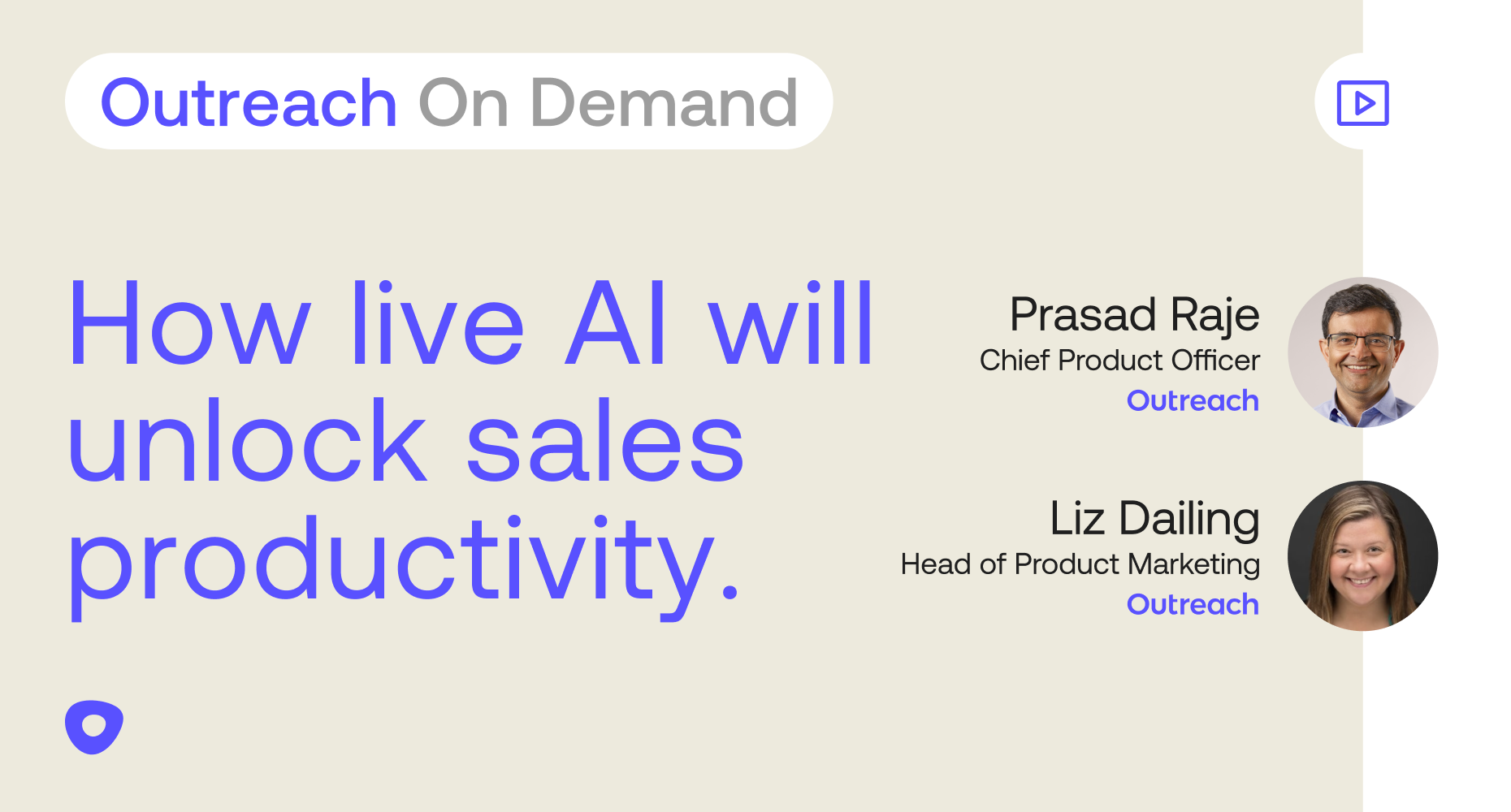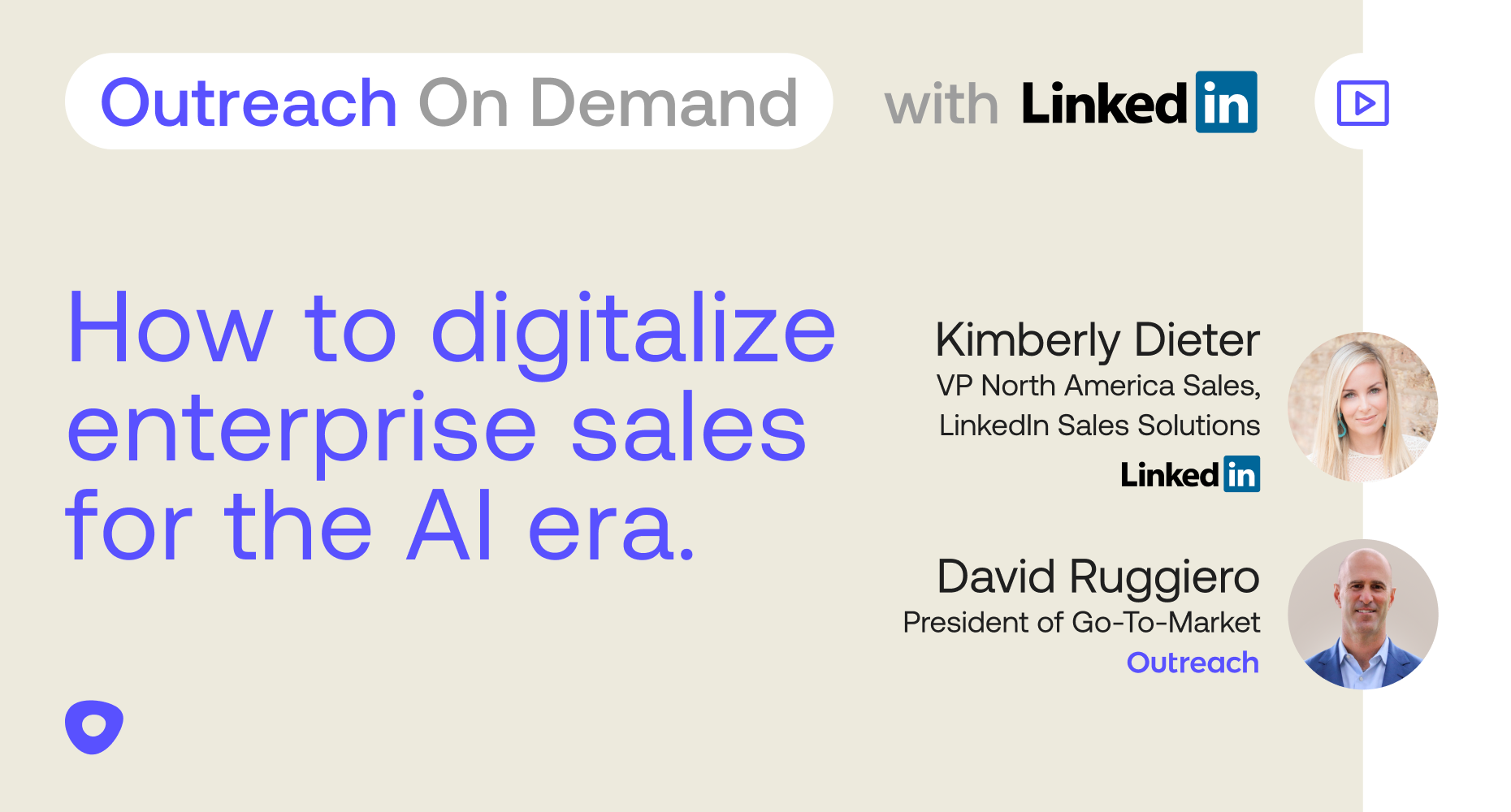Every sales leader struggles to achieve consistent execution. What if sales leaders could give sellers a superpower to be more efficient, productive, and relevant? That’s the question Outreach Chief Product Officer Prasad Raje and I set out to discuss in a recent webinar regarding the future of AI within sales.
AI built into every stage of the sales cycle is a force multiplier. But it’s clear sales leaders and their teams need time to figure out how sales AI is going to impact them. When we asked our followers on LinkedIn how their team is using generative AI in sales, the results were mixed.
Only 10% have AI fully baked into their process, while the majority (42%) are using it in the sales process but could do more. And the other half of sales teams are either not using generative AI due to trust (19%) or don’t know where to start (30%).
It’s the wild west out there. So, strap in as we recap the biggest takeaways from the conversation. Keep reading for insights the role of AI in sales and where sales teams can easily leverage its capabilities for AI-powered sales execution.
Generative AI + the evolution of content
You won’t find a business or sales conversation that doesn’t include AI right now. We’re living through an important moment, but why does this one feel so compelling? It helps to look at the evolution and revolution of content.
Let’s start with the humble genesis of AI – the printing press. Its arrival revolutionized content replication, unlocking the power to produce manuscripts at scale and creating a global shift toward literacy.
Next came the emergence of the internet, propelling content transmission to unprecedented scales. Then, the advent of smartphones not long after transformed content consumption, allowing people across the globe to instantaneously consume content no matter where they were.
Now, we’re witnessing another technological revolution that’s on the level of the ones that came before it — generative AI — encompassing content synthesis, creation, and insight extraction on a large scale.
Embracing predictive sales AI as an advantage
You can’t talk about using AI in sales without addressing the elephant in the room: jobs.
The rise of generative AI has sparked concerns about its threat to human jobs. Advances in the past have impacted more physical labor, but this is new. It’s a revolution that’s hit information workers, challenging how we work and create.
But, as Prasad notes, we need to shift perspectives.
“The number one thing people should worry about is not an AI replacing their job.” Prasad continues, “The number one thing they should worry about is another human who's suddenly become much more productive because they're using AI.”
Delegating time-wasting tasks to sales AI and managing the information overload that plagues information workers today is the goal. And data shows that’s what business leaders are focused on. In fact, business leaders are twice as interested in using AI to increase productivity than in cutting headcount.
But AI is also a productivity panacea. Nearly 70% of respondents expressed their willingness to delegate as much work as possible to AI to alleviate their own workloads.
TL;DR: it is crucial to embrace predictive sales AI as an advantage. By harnessing its power, we can unlock new levels of sales productivity and innovation and get to customer value faster.
How generative AI aids sales execution workflows today
In this new era of B2B sales, sales teams everywhere face unique challenges. Inbound demand has decreased, marketing budgets are tightening, and fewer sellers are called to take on the work of creating more of their own pipeline and closing deals. Even so, the challenges of accelerating deal velocity and boosting win rates remain.
That’s where AI in B2B sales comes in, empowering sales teams to optimize their sales execution workflows, ramp up seller productivity, and achieve better outcomes. Let's explore some examples of how AI aids sales execution workflows today:
Authors to editors
AI can act as an intelligent editor for sales content, analyzing and suggesting improvements in real time. It ensures that every email, proposal, or presentation is tailored to resonate with prospects. Sellers save valuable time and increase the quality and impact of their communications.
In the moment vs. after the fact
AI equips sellers with real-time guidance during sales conversations, providing them with relevant information, suggested responses, and even predicting customer objections. Sellers can then be more agile and effective in their interactions, delivering personalized and engaging experiences to prospects.
Insights to actions
AI-powered analytics can synthesize data and extract actionable insights. Sales leaders can leverage these insights to make informed decisions, prioritize leads, identify upselling opportunities, and optimize sales strategies. This data-driven approach allows sales teams to focus on the most promising prospects, create a robust pipeline, and close more deals.
The problem with generic AI
Not every AI is made the same. And for sales leaders who want to capitalize on its productivity advantage, you need to identify what sets them apart.
For example, large language models are available on the market. But using them as-is for selling can lead to problems. Why? LLMs have been trained by data available on the open internet, and they can synthesize output based on that knowledge and training. But what they lack is the data that resides within a company, such as:
- History-based context: Emails, calls, meetings, etc. that ensure relevancy from prior conversations.
- Seller-based accuracy: Seller’s facts (i.e., PnP, market position, competitive offers) with recent updates.
- Buyer-based specificity: Buyer’s facts (e.g., price quoted, quantity ordered) that must be included for personalization.
Imagine what would happen if you gave Company X a 20% percent discounted price and Company Y a 30% discounted price, but the generated response mixed them up. That may get a seller into some trouble.
“Beware of the toys. Rather, examine for actual robustness to solve business challenges and deliver value.”
What sales leaders should do when examining sales AI
As a sales leader, you may feel like this innovation is exploding all around you. And you need to be cognizant that you’re going to be thrown AI from every direction. To determine what vendor is doing the best work, our speakers recommend asking these three questions:
- Where is the solution you’re looking at getting its context from it? Does it have enough context in the setting conversation?
- Does it have enough specificity to the buyers that you’re selling to?
- Does it have the accuracy to ground the truth of your data?
To ensure sellers are set up to win, we encourage sales leaders everywhere to beware of the toys. Rather, examine for actual robustness to solve business challenges and deliver value.
How Outreach adds value to leverage large language models
Context, accuracy, and specificity are built into Outreach’s AI capabilities, starting with a vast amount of customer data that serves as the foundation.
Outreach’s natural language processing AI technology then extracts the relevant information from the content, including pricing, competitors, and more. It ensures only the relevant details are used while preserving the meaning needed to construct a response.
And we also know the importance of data protection and governance. Outreach AI adds a layer of control to restrict and manage the information released for further processing, so customer data is always handled securely and in compliance with privacy regulations.
It’s this combination of customer data, natural language processing, relevance extraction, and seamless integration within existing workflows that allow Outreach to deliver AI-powered interactions with context, accuracy, and specificity.
How Outreach delivers generative AI to customers
AI has been part of Outreach for a long time and plays a crucial role in how we deliver value to our customers. In fact, Outreach is the only AI-powered Sales Execution Platform that unlocks seller productivity to help sales teams efficiently create and close more pipeline. With a foundation of more than 33 million weekly action-outcome pairings and over 6,000 customers, both sellers and revenue leaders benefit from AI-driven insights driving targeted actions. Here we’ll look at just a few different AI-powered capabilities of the Outreach platform.
Authors to editors with Smart Email Assist
Outreach's Smart Email Assist auto-generates accurate and relevant email copy based on the prior context of conversations between buyers and sellers. Reps become editors, instead of spending the mental energy required to craft a response from scratch. In other words, reps gain efficiency, without sacrificing quality or the ability to personalize.
In the moment with Kaia
Outreach’s conversation intelligence is powered by Kaia™, an AI-powered virtual assistant, that joins seller’s meeting live. Kaia records and transcribes the meeting, but also recognizes the context of the conversation to surface relevant content to the seller in the moment. That way, sellers are never caught off guard and can respond to questions as they’re being asked rather than after the fact.
Insights to actions with Deal Health Score
Another aspect of Outreach's AI capabilities is the provision of a health score for deals. Our AI engine considers all deal-related activities and generates a summary view, represented by a red, yellow, or green score. Sales leaders and their teams can then take appropriate actions to ensure deals progress smoothly or save at-risk deals.
Using AI in sales: What you need to know
Generative AI built into every stage of the sales process — where sales teams easily leverage its capabilities right within their workflows — has limitless potential. So, what advice would we give sales leaders who may be reluctant to dig into AI right now?
“The short answer is: don’t wait.” Prasad urges everyone to embrace the change. “This is here to stay. This is one of the biggest technology shifts in the entire technology industry. It’s not a fad or a passing phase, and it’s not going away.”
At the same time, don’t let the weight of everyone jumping on the bandwagon get to you. Their recommendation is to ask those core questions of vendors coming your way and find the ones that will help you solve your sales challenges. Because employees will be looking to you for this, to take advantage of it and move their skill sets. Sales leaders have an opportunity to take on this charge and deliver greater productivity and sales outcomes because of it.
For more insights from top sales leaders, follow Outreach on LinkedIn. You'll get daily tips and strategies to help you create and close more pipeline in 2023. And if you're looking for a deep dive into this topic, check out the full 60-minute session: How live AI will unlock sales productivity.
Stay up-to-date with all things Outreach
Get the latest product news, industry insights, and valuable resources in your inbox.


